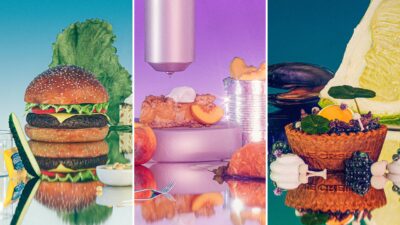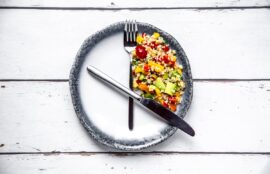
Dr. Morgaine Gaye sweeps a hand over her blonde faux-hawk and smiles at me through oversize purple-tinted glasses. If she doesn’t look the part of a self-proclaimed “food futurologist,” I don’t know who does. The future, she tells me in her rapid-fire British accent, is all about Air Protein, a product that uses high-tech fermentation to turn carbon dioxide into chicken or whatever you want, really. Tens of millions of dollars are being invested into alternative proteins and air just might be one of the keys to feeding the world’s 9.8 billion people by 2050.
That’s nearly 2 billion more people than we (fail to) feed today, and an overwhelming amount of that growth, the UN predicts, will be in sub-Saharan Africa, where desert conditions make farming a challenge. Then there’s that pesky issue of climate change. If the planet warms 2.7 degrees by 2040, as experts project, the implications could be devastating. Ongoing droughts, flooding, extreme weather, it’s all on the table. What may not be on the table: California avocados, predicted to go all but extinct by 2050.
The good news is that the food industry is already planning for those pressures, as Amanda Little investigates in her revelatory book The Fate of Food. “I don’t know that there’s a future in which we’re all looking at a plate of wafers injected with specialized nutrients,” she says. “That just sounds like a culinary hell nobody wants to inhabit.” It’s the seeds, farming practices, technology, water, distribution, and behind-the-scenes innovations that are going to change the contents of our plates. She’s rooting for the avocados (though they might have to be grown indoors…and cost $20 a pop).
To take a look at what the future of food might look like, we talked to experts to come up with menu predictions for the future. For the years 2023 and 2024, scientists offered their insights on how food might change. But for 100 years from now—the year 2122—we spoke with people who were unafraid to make some bold claims: science fiction writers. See it all below.
2032: 10 Years
Within the next decade, grocery stores will stock cell-cultured proteins. Stem cells are collected, put into bioreactors, and fed nutrients like glucose so that they grow into animal-free chicken, beef, pork, and even duck (as opposed to the meat alternatives we have today, which are very good imitations made with plant products). These proteins don’t need room to graze and expel methane, don’t waste uneaten parts of an animal, and are less likely to contain bacteria like salmonella. This is the beyond-Beyond burger.
The Menu
- Upside Foods’ cell-cultured hamburger, concocted in a lab in Berkeley, CA.
- Animal-free American cheese made with protein powder brand Perfect Day’s patented cow-free whey protein.
- Bun baked with Kernza wheat, a hearty grain with long roots that retain water and rejuvenate the soil.
- Good old-fashioned pickles aren’t going anywhere—don’t panic.
- Hummus made with genetically edited chickpeas that can withstand extreme heat and drought.
- Food-waste-eliminating upcycled barley croutons fortified with algae powder (it’s nutrient-dense and a great binder, plus algae draws out more CO2 in the air than trees do).
- Side salad with romaine lettuce from an indoor vertical farm, which can bring local produce to densely packed city centers (where populations are predicted to double by 2050) without the need for farmland or even sun.
- Hidden Valley Ranch dressing, still the reigning ranch champ, but hopefully from a compostable squeeze bottle by then
- A squeaky-clean glass of locally (hyper-) filtered, recycled, delicious sewage water. In the next decade much of the world will experience shortages of fresh water and its cost will increase, especially in dry climates that already import water, like California.
2042: 20 Years
Personalized nutrition was the phrase I heard most from food industry experts, like the head of R&D at PepsiCo, which recently launched a sweat patch to tell you when you need more Gatorade (often). What 23andMe did for genetics, we’ll see in the nutrition and gut-health departments. Imagine a wristwatch that pings you when your sodium’s high. Cool! Creepy!
The Menu
- Sustainably farmed, zero-waste salmon. Yes, we already have this, but the demand for proteins is predicted to increase 40 percent by 2050. Farmed salmon has a long way to go to be safer and less ridden with sea lice (don’t ask), but if people eat more fish than beef by 2042, we’ll be doing the planet a lot of good.
- Protein-enhanced lentils—hey, the watch said you needed it—in a coconut milk broth seasoned with local greenhouse peppers because extreme weather in Latin America has made the imported ones too expensive.
- Iced coffee made from medium-acidic, very tasty Coffea stenophyllabeans that can withstand warmer temperatures. Experts predict some 60 percent of coffee species could go extinct in the next 20 years due to extreme weather, deforestation, and human development.
- Air fryers are out. Countertop 3D-printing ovens that transform shelf-stable foods into hot dishes are IN! This one baked you a tasty peach cobbler from canned peaches that were genetically edited for “low-chill” conditions (peaches need time in the cold to develop to their full potential, and warmer winters are already ruining entire crops).
- Topped with crème fraîche (pricey but worth it) made of cream from a nearby midsize regenerative farm, which we’ll need to revive our soil and ensure a more reliable food supply. Certain staples of the American diet—meat, poultry, dairy—will forever remain in demand.
2122: 100 Years
Four science fiction writers with buzzy, brilliant books out this year muse on what they think we’ll be eating one hundred years from now. Thankfully, no one said Soylent Green.
The Menu
- Cricket tartare (Portland-biodome-raised, certified organic) on a bed of Mariana Trench plankton from the deepest point in the Pacific Ocean, where we have yet to explore the possibilities of food. It’s served in an edible fungi tart dish from Le Creuset, a brand that will surely endure even as culinary innovations move from kitchens to biotech labs. This snack is brought to you by the inventive mind of Sequoia Nagamatsu, author of How High We Go in the Dark, which spans generations (and atmospheres) drastically shaped by a devastating worldwide plague…
- Sustainably farmed mussels in a citrus broth covered by a gigantic supremed lime, says Sarah Blake. She’s the author of Clean Air, which takes place in a near-distant future where plants overproduce deadly pollen to save the planet’s ecosystems, killing a ton of humans while the rest live in domes and eat oversize produce farmed by robots.
- In Goliath, novelist Tochi Onyebuchi imagines a future in which the rich have taken off for space colonies, leaving the rest on radiation-ruined Earth. A hundred years from now, coffee beans will be extinct (a real possibility), so Onyebuchi has us sipping java made from okra seeds, a significant cultural touchstone of Black cuisine even in the postapocalypse.
- 3D-printed tortilla chips made from hydroponic black bean paste, with cell-cloned cheese sauce and jalapeños, all sourced from aerial farms in the upper atmosphere of Venus. In her optimistic vision of the future, author Martha Wells sees people living on space stations or on other planets after Earth’s resources have been depleted (you don’t want to hear the pessimistic version!). Wells’s next fantasy series, Witch King, is out May 2023.
Original article here






















Sorry, the comment form is closed at this time.